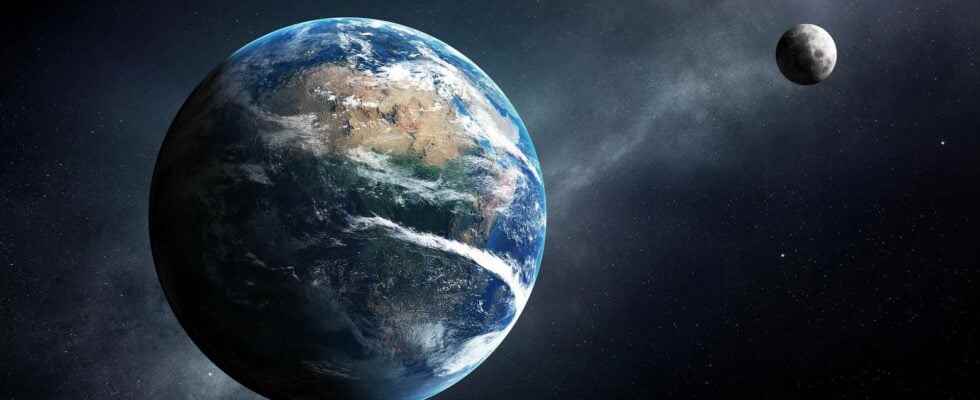The waltz of the continents is part of the geological history of the Earth. Carried away by the tectonics of the plates, the continental masses did not stop gathering in supercontinents before fragmenting, to gather again. Four supercontinents would have thus formed during the history of the Earth.
You will also be interested
[EN VIDÉO] A billion years summed up in 40 seconds: plate tectonics Researchers have modeled the movements of tectonic plates over the past billion years.
The Earth being a sphere, the movements tectonics have no other choice but to alternate continental configurations. This is called the Wilson cycle : under the effect of tectonic forces, the continents are alternately gathered in the form of a supercontinent, then fragmented.
From Ur to Columbia
The duration of a cycle is thus several hundreds of millions of years (300 to 500 Ma). Currently, the pattern that we observe on the surface of the globe certainly represents the maximum state of fragmentation. The last supercontinent that preceded this configuration is well known as Pangea. But several cycles preceded it, leading to the formation of four supercontinents.
Wilson cycles have followed one another, at least for 2.5 billion years, perhaps more. To find traces of the first continents and their morphology is not easy, as the continental rocks were then reworked by the various tectonic episodes that followed (collision, subduction, erosion). The markers of the primitive continents are particularly tenuous, but scientists have elements allowing to say that the first continents would have been formed over 3 billion years ago.
The assembly of masses Continents so early in Earth’s history is, however, much debated. Several models exist. One of them proposes that the Ur continent would be the first supercontinent in Earth’s geological history, but several other continents could also have coexisted. Traces of Ur are currently found in rocks in India, South Africa and Australia.
A first supercontinent, named Columbia or Nuna / Nena, would have been formed by the aggregation of these primitive continents, 1.8 to 1.5 billion years ago. Traces of it can be found today in many current continents such as North America, Australia, Siberia, North China, the Kalahari, Ukraine and the Amazon.
Rodinia: the first well-documented supercontinent
The fragmentation of Columbia would have started about 1.5 billion years ago, to give birth to several continents that would have gradually separated to come together at the end of the Wilson cycle in the form of a new supercontinent: Rodinia . The formation of Rodinia would have started 1.1 billion years ago. Better documented, because more recent, Rodinia would thus have been composed mainly of craton North American, also known as Laurentia, East European craton (Baltica), and Amazonia, West Africa, Australia and Antarctica cratons.
The fragmentation of Rodinia took place 750-633 million years ago. It is associated with a particularly cold period in the history of the Earth (snowball earth) as well as a rapid evolution of primitive life (Ediacaran fauna). This explosion of life on Earth could be linked to this phase of opening and separation continental.
Pannotia, a supercontinent with multiple appellations
Following the disintegration of Rodinia, a new supercontinent will form around the South Pole, around 633-573 million years ago (Ma): Pannotia, also called Gondwanaland, supercontinent Vendée or Pan-African supercontinent. African cratons occupy a central place there. All around we find the future continents Laurentia, Baltica, Australia, Siberia and Antarctica. Its existence will be of relatively short duration, since it will begin to fragment 560 Ma ago. Within this immense continental mass will open several oceans, including the Iapetus Ocean. This opening phase is accompanied by significant changes: rise in sea level, climate change extreme and modification of the chemistry oceans. It is also accompanied by the Cambrian explosion, which marks the rapid and sudden development of metazoa, like trilobites, thanks to the diversification of habitats generated by these multiple oceanic openings.
Pangea
Finally, 335 Ma ago, the Pangea supercontinent was formed. It is the most recent supercontinent. Centered on the equator, it is surrounded by a gigantic ocean, named Panthalassa. The existence of this supercontinent was highlighted by Alfred Wegener, father of the theory of tectonic plates, thanks to the uniformity of the distribution of fossils on the different current continents. It is also supported by the continuity of certain large geological structures, in particular between South America and Africa.
Like all the other supercontinents, Pangea will end up fragmenting at the beginning of the Jurassic, around 175 Ma. North America and Africa will thus begin to separate to give birth to a new ocean: the central Atlantic. Pangea is then separated into two main blocks: Laurasia in the North and Gondwana South. The rifting and oceanic opening processes of each of these two blocks will end up giving the continental configuration that we know today.
Amasia, future supercontinent?
Currently, we are halfway through the Wilson cycle. A new supercontinent, Amasia, should thus form within 50 to 200 Ma, according to scientists’ extrapolations. The continents should thus regroup near the North Pole. New mountain ranges will form following the closure of the Pacific Ocean and the collision of the American and Eurasian plates, but also following the collision between Africa and Asia.
Interested in what you just read?
.
fs12
